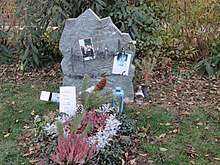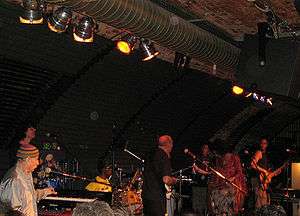Joe Zawinul
Josef Erich Zawinul (7 July 1932 – 11 September 2007)[1] was an Austrian jazz keyboardist and composer. First coming to prominence with saxophonist Cannonball Adderley, Zawinul went on to play with Miles Davis and to become one of the creators of jazz fusion, a musical genre that combined jazz with rock. He co-founded the groups Weather Report and The Zawinul Syndicate. He pioneered the use of electric piano and synthesizer, and was named "Best Electric Keyboardist" twenty-eight times by the readers of Down Beat magazine.[2]
Joe Zawinul | |
|---|---|
 Joe Zawinul with the Zawinul Syndicate (Freiburg, Germany, 2007) | |
| Background information | |
| Birth name | Josef Erich Zawinul |
| Born | 7 July 1932 Vienna, Austria |
| Died | 11 September 2007 (aged 75) Vienna |
| Genres | Jazz, jazz fusion, world |
| Occupation(s) | Musician |
| Instruments | Keyboards |
| Years active | 1949–2007 |
| Labels | Columbia, ESC |
| Associated acts | Cannonball Adderley, Nat Adderley, Miles Davis, Weather Report, Zawinul Syndicate |
| Website | joezawinul |
Biography
Early life and career
Zawinul grew up in Vienna, Austria. Accordion was his first instrument. When he was six or seven, he studied clarinet, violin, and piano at the Vienna Conservatory[3] (Konservatorium Wien). During the 1950s he was a staff pianist for Polydor. He worked as a jazz musician with Hans Koller, Friedrich Gulda, Karl Drewo, and Fatty George.[4] In 1959 he moved to the U.S. to attend Berklee College of Music, but a week later he received a job offer from Maynard Ferguson, so he left school and went on tour.[3] He then accompanied Dinah Washington.[5] He spent most of the 1960s with Cannonball Adderley. During this time he wrote "Mercy, Mercy, Mercy" and "Walk Tall", and "Country Preacher" and played electric piano. At the end of the decade he recorded with Miles Davis on In a Silent Way as Davis was establishing the genre of jazz fusion, combining jazz with rock.[1]
With Weather Report

In 1970, Zawinul founded Weather Report with Wayne Shorter.[4] Their first two years emphasized a relatively open, group improvisation format similar to what Miles Davis was doing in a more rock oriented format. However, Zawinul started making changes with their third album, Sweetnighter. Funk elements such as bass guitar and wah-wah pedal began to be introduced to the band's sound. With the fourth album, Mysterious Traveller, the musical forms were composed similar to classical music, and the combination of jazz harmonies with 1970s groove helped move the band into its most commercially successful period.
The band's biggest commercial success came from Zawinul's composition "Birdland" on the 1977 album Heavy Weather, which peaked at number 30 on the Billboard pop albums chart. "Birdland" is one of the most recognizable jazz pieces of the 1970s, recorded by The Manhattan Transfer, Quincy Jones, Maynard Ferguson, and Buddy Rich. The song won him three Grammys.
Weather Report was active until the mid-1980s, with Zawinul and Shorter remaining the sole constant members through multiple personnel shifts. Shorter and Zawinul went separate ways after recording Sportin' Life, but it was discovered they had to do one more album to fulfill their contract with CBS Records. This Is This! therefore became the band's final album.
In 1991, Zawinul was awarded an Honorary Doctorate of Music from Berklee College of Music and on this occasion performed with a group consisting of Matthew Garrison, Torsten de Winkel, Abe Laboriel Jr. and Melvin Butler.[6]
With The Zawinul Syndicate
The Zawinul Syndicate was a jazz fusion band formed in 1988. It evolved out of Weather Report.[7] Their style could be described as a combination of unusual grooves, driving and swinging rhythms and many borrowings from different music cultures.
Zawinul himself stated that he gave the band its name due to a syndicate bearing more resemblance to a family than "just" a band.[8]
After the death of Zawinul in 2007, several members of The Zawinul Syndicate decided to reform and performing Zawinul's music live under their shortened name The Syndicate.[9]
Here's a list of several major members of the Syndicate over the years: Scott Henderson, Bobby Thomas Jr, Linley Marthe, Paco Sery, Manolo Badrena, Nathaniel Townsley, Sabine Kabongo, Gary Poulson, Richard Bona, Victor Bailey.
Stories of the Danube
Zawinul also wrote a symphony, called Stories of the Danube, which was commissioned by the Brucknerhaus, Linz. It was first performed as part of the Linzer Klangwolke (a large-scale open-air broadcast event), for the opening of the 1993 Bruckner Festival in Linz. In its seven movements, the symphony traces the course of the Danube from Donaueschingen through various countries ending at the Black Sea. It was recorded in 1995 by the Czech State Philharmonic Orchestra, Brno, conducted by Caspar Richter.
Death

Zawinul became ill and was hospitalized in his native Vienna on 7 August 2007,[10] after concluding a five-week European tour. He died a little over a month later from a rare form of skin cancer (Merkel cell carcinoma) on September 11, 2007.[11][12] He was cremated at Feuerhalle Simmering and his ashes buried in Vienna Central Cemetery.
Discography

As leader
- To You With Love (Strand, 1961)
- Soulmates with Ben Webster (Riverside, 1963)
- Money in the Pocket (Atlantic, 1966)
- The Rise and Fall of the Third Stream (Vortex, 1968)
- Zawinul (Atlantic, 1971)
- Di•a•lects (Columbia, 1986)
- The Immigrants (Columbia, 1988)
- Music for Two Pianos with Friedrich Gulda (Capriccio, 1988)
- Black Water (Columbia, 1989)
- Lost Tribes (Columbia, 1992)
- My People (ESC, 1996)
- Stories of the Danube (Polygram, 1996)
- World Tour (ESC, 1998)
- Mauthausen - Vom großen Sterben hören (ESC, 2000)
- Faces & Places (ESC, 2002)
- Vienna Nights: Live at Joe Zawinul's Birdland (BHM, 2005)
- Brown Street (Heads Up, 2007)
- 75 (Heads Up, 2009)[13]
- Absolute Zawinul (The Absolute Ensemble, conducted by Kristian Järvi) (Intuition, 2009)
- Weather Report (Columbia, 1971)
- I Sing the Body Electric (Columbia, 1972)
- Live in Tokyo (Columbia, 1972)
- Sweetnighter (Columbia, 1973)
- Mysterious Traveller (Columbia, 1974)
- Tale Spinnin' (Columbia, 1975)
- Black Market (Columbia, 1976)
- Heavy Weather (Columbia, 1977)
- Mr. Gone (Columbia, 1978)
- 8:30 (Columbia, 1979)
- Night Passage (Columbia, 1980)
- Weather Report (Columbia, 1982)
- Procession (Columbia, 1983)
- Domino Theory (Columbia, 1984)
- Sportin' Life (Columbia, 1985)
- This Is This! (Columbia, 1986)
- Live and Unreleased (Columbia, 2002)
- Forecast: Tomorrow (2006)
As sideman
With Cannonball Adderley
- Nancy Wilson/Cannonball Adderley (Capitol, 1961)
- The Cannonball Adderley Sextet in New York (Riverside, 1962)
- Cannonball in Europe! (Riverside, 1962)
- Jazz Workshop Revisited (Riverside, 1963)
- Autumn Leaves (Riverside [Japan], 1963)
- Nippon Soul (Riverside, 1963)
- The Sextet (Milestone, 1962-63 [1982])
- Cannonball Adderley Live! (Capitol, 1964)
- Live Session! (Capitol, 1964)
- Cannonball Adderley's Fiddler on the Roof (Capitol, 1964)
- Domination (Capitol, 1965)
- Money in the Pocket (Capitol, 1966)
- Great Love Themes (Capitol, 1966)
- Mercy, Mercy, Mercy! Live at 'The Club' (Capitol, 1966)
- Cannonball in Japan (Capitol, 1966)
- Radio Nights (Night, 1967-8)
- 74 Miles Away (Capitol, 1967)
- Why Am I Treated So Bad! (Capitol, 1967)
- Accent on Africa (Capitol, 1968)
- Country Preacher (Capitol, 1969)
- In Person (Capitol, 1970)
- The Cannonball Adderley Quintet & Orchestra (Capitol, 1970)
- The Price You Got to Pay to Be Free (Capitol, 1970)
With Nat Adderley
- Naturally! (Jazzland, 1961)
- Autobiography (Atlantic, 1964)
- Live at Memory Lane (Atlantic, 1966)
- The Scavenger (Milestone, 1968)
- You, Baby (CTI, 1968)
- Calling Out Loud (CTI, 1968)
With Miles Davis
- In a Silent Way (Columbia, 1969)
- Bitches Brew (Columbia, 1970)
- Live-Evil (Columbia, 1971)
- Big Fun (Columbia, 1974)
- Circle in the Round (Columbia, 1979)
With Victor Feldman
- Soviet Jazz Themes (Äva, 1962)
With Jimmy Forrest
- Out of the Forrest (Prestige, 1961)
With Eddie Harris
- Silver Cycles (Atlantic, 1968)
With Sam Jones
- Down Home (Riverside, 1962)
With Yusef Lateef
- The Centaur and the Phoenix (Riverside, 1960)
- Suite 16 (Atlantic, 1970)
With Herbie Mann
- A Mann & A Woman (Atlantic, 1966) with Tamiko Jones
- The Beat Goes On (Atlantic, 1967)
- The Many Facets of David Newman (Atlantic, 1969)
With Dinah Washington
- What a Diff'rence a Day Makes! (Mercury, 1960)
- The Two of Us (Mercury, 1960)
With Quincy Jones
- Back On the Block (Quest/Warner Bros, 1989)
With Katia Labèque
- Little Girl Blue (Dreyfus, 1995)
With Trilok Gurtu
- Crazy Saints (Creative Music Production, 1993)
References
- Richard S. Ginell. "Joe Zawinul". AllMusic. Retrieved 7 February 2018.
- Archived 11 February 2010 at the Wayback Machine
- Walters, John L. (13 September 2007). "Obituary: Joe Zawinul". The Guardian. Retrieved 23 January 2019.
- Kernfeld, Barry (2002). Kernfeld, Barry (ed.). The New Grove Dictionary of Jazz. 3 (2 ed.). New York: Grove's Dictionaries. pp. 1015–1016. ISBN 1-56159-284-6.
- "Zawinul, Joe". Encyclopedia of World Biography, v. 28 (2nd ed.). Detroit: Gale. 2008. p. 389.391. ISBN 9780787622213.
- "Joe Zawinul, 75, influential jazz keyboardist". Archive.boston.com. Retrieved 28 December 2017.
- "Joe Zawinul | Biography & History | AllMusic". AllMusic. Retrieved 2017-08-22.
- Bianchi, Curt. "Zawinul Online » 20 Years of the Zawinul Syndicate". www.zawinulonline.org. Retrieved 2017-08-22.
- Bianchi, Curt. "Zawinul Online » 2015 Tour Dates". www.zawinulonline.org. Retrieved 2017-08-22.
- Curt Bianchi (7 August 2007). "Joe Zawinul Hospitalized in Vienna". Zawinulonline.org. Retrieved 11 January 2016.
- McDonald, Ray (12 September 2007). "Keyboardist Joe Zawinul Dies". VOA News. Voice of America. Archived from the original on 16 January 2009. Retrieved 2 January 2009.
- Schudel, Matt (12 September 2007). "Joe Zawinul, 75; Keyboardist Was a Pioneer of Jazz Fusion". The Washington Post. Retrieved 6 May 2010.
- "Joe Zawinul | Album Discography". AllMusic. Retrieved 22 January 2019.
Biographies
- Glasser, Brian (2001). In a Silent Way: A Portrait of Joe Zawinul. London: Sanctuary. ISBN 1-86074-326-9. OCLC 45900631.
- Baumann, Gunther (2002). Zawinul: Ein Leben aus Jazz [Zawinul: A Life of Jazz] (in German). Salzburg; Wien: Frankfurt am Main; Residenz. ISBN 3-7017-1291-3. OCLC 469270497.
- Yamashita, Kunihiko (2006). Joe Zawinul: On the Creative Process. Tokyo: Rittor Music. ISBN 4-8456-1337-9. OCLC 169983180.
Further reading
External links
| Wikimedia Commons has media related to Joe Zawinul. |
| Wikiquote has quotations related to: Joe Zawinul |